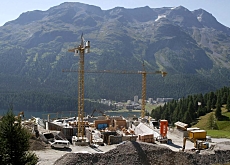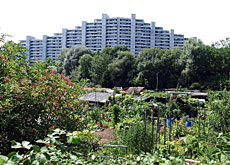Action demanded to stop urban sprawl

A majority of Swiss residents want to see a stop to urban sprawl, according to the environmental organisation, Pro Natura.
A survey found that 52 per cent of people surveyed felt too much land was being developed, while only 34 per cent thought the current rate of land loss was acceptable.
Carried out by the gfs-zürich research institute, the survey also found that 80 per cent of people questioned opposed the development of “particularly beautiful landscapes”.
The survey paves the way for a people’s initiative to bring the issue of urban sprawl to a nationwide vote, which Pro Natura intends to launch along with other environmental organisations.
“Every second, a square metre of land disappears under concrete and asphalt,” Pro Natura said in a statement.
“The land cannot be reclaimed. It is not a renewable resource, but a rare and valuable asset.”
According to the Federal Office for Spatial Development, three-quarters of the population resides in Switzerland’s agglomerations, which extend from the core towns and cities far out into the countryside.
It said in its 2005 report that these agglomerations are marked by “sparsely populated regions featuring extensive estates of detached housing, unstructured industrial and business zones, shopping centres and leisure areas with enormous car parks”.
The office added that the land taken up by these agglomerations “has been growing faster than the total population” with the “countryside losing much of its rural character”.

More
People’s initiative
Centralisation
The release of the 2005 report was an attempt by the federal authorities to convince parliament to try to impose greater restrictions, favouring more centralisation.
Responsibility for planning and construction laws lies mainly with the cantons and communes, which rarely adhere to legal frameworks set down by the federal government.
This feature has led to an unwieldy mass of norms, definitions and concepts, with every canton and commune planning and building without reference to the regional needs and requirements.
The office has recommended that various sectors, such as environmental conservation, agriculture, regional planning and transportation, be better coordinated since they all have an impact on land use.
“Efforts must be made to bring the following areas, in particular, more into line with each other at federal level,” it concluded.
swissinfo with agencies
– Tougher requirements for cantonal structural plans
– A national urban development plan
– Quotas for building zones and urban land area
– Review of building zones
– Framework conditions for the development of building zones
– Requirements for the accessibility of urban areas by public transport
– Introduction of minimum land usage coefficients
– Creation of an urban regeneration plan.

In compliance with the JTI standards
More: SWI swissinfo.ch certified by the Journalism Trust Initiative



You can find an overview of ongoing debates with our journalists here. Please join us!
If you want to start a conversation about a topic raised in this article or want to report factual errors, email us at english@swissinfo.ch.